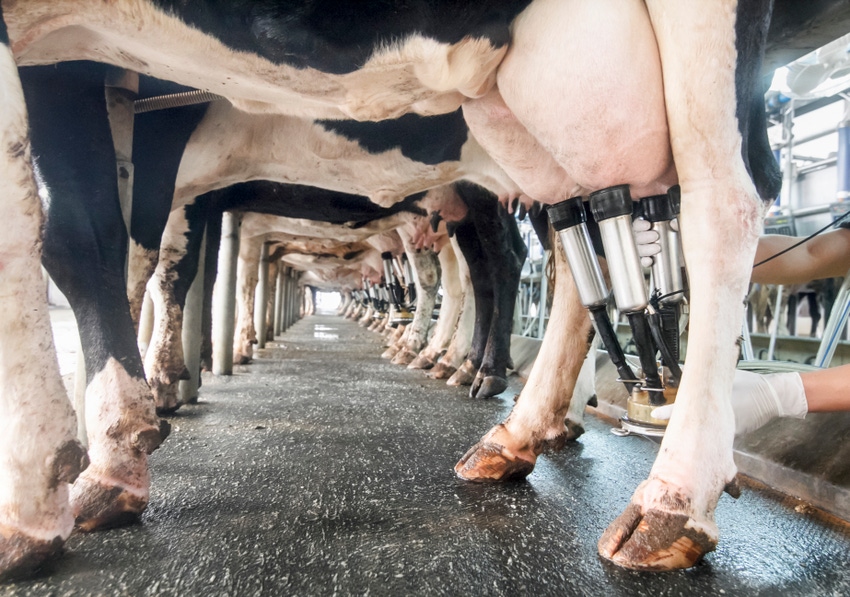Dairy farmers hurting despite domestic bright spots
Domestic cheese and butter sales through July both higher year over year.

Dairy farmers are really hurting during a year that was supposed to be a recovery time following two years of lower markets, Tom Gallagher, chief executive officer of Dairy Management Inc. (DMI), told the press during an event held in conjunction with the 2018 World Dairy Expo in Madison, Wis.
“Right through May, everything looked pretty good. The first seven months of the year in exports, we set records -- the best seven months we’ve ever had,” he said.
Domestic cheese sales are up 2.6% this year, Gallagher said, explaining that some of that increase was driven by retail demand, while much more of the increase was due to foodservice demand from dairy checkoff partner companies like McDonald’s, Pizza Hut, Taco Bell and others
Butter sales were also up through July, rising about 1.5% due to a resurgence of people looking at fats differently.
Domestic sales for yogurt, powder and fluid milk, on the other hand, were all down through July.
“Overall, if you look at the end of May going into June, sales were good. This would be considered a good year so far,” Gallagher said, adding that domestic and export sales were up 2.3% total.
Production was up 1.1%, which is not a “startling” number, he added.
“Futures looked great on May 31, and then we had the [trade] tariffs and the retaliatory tariffs. Futures one day were fine, and then a couple days later, they dropped like a rock. There was about a $1.2 billion loss from that point forward in the futures,” he said.
As these tariffs go on for longer, cheese sales will be affected.
Gallagher explained that several cheese companies took the position that they would pay the difference in the tariffs so they didn’t lose their customers, “but they can only do that for so long. Some of them have said [they can do it] through the end of the year.”
The sooner the new U.S.-Mexico-Canada Agreement (USMCA) progresses enough to remove the tariffs, the better, Gallagher said; otherwise, the U.S. dairy industry is in “for a rough time.”
As of right now, there’s no clear indication of when that might be, he added.
DMI also contacted with foodservice partners to try to offset some of the tariff impact by driving increased demand. Gallagher said each partner offered to try to drive demand to help dairy farmers in the second half of 2018.
“The first half of the year for cheese in foodservice was excellent, and the back half I think will be even better,” he said. “They’ve really done some cheese-centric things for us, all of which checkoff employees developed.”
Gallagher believes butter sales, from a retail and foodservice perspective, will remain solid during the remainder of the year.
Fluid milk a disaster
Fluid milk has been a disaster and in crisis for years, Gallagher told attendees. Total domestic fluid milk sales through July have dropped approximately 2% in each of the last two years.
“We’ve got some ideas there to once again try to bring a sense of urgency to the industry,” he said. “I still believe fluid milk can be a growth market to us if we follow the lead of companies, like Fairlife, who have been wildly successful.”
DMI is wrapping up a successful three-year relationship with Fairlife, which Gallagher said should be a model for the industry.
“You can’t just take a gallon and just drop it on the shelf,” he said, adding that Fairlife has spent more than $100 million per year on marketing campaigns over three years.
“They’ve done a great job, and this year we’re ending our partnership because now they’re past breakeven. They’re going to hit about $450 million in sales. Over the next couple years, they’ll be near three-quarter of a million,” he noted.
Gallagher emphasized the need to be a brand and spend money to support that brand. Additionally, he said interaction with consumers is important.
“I’m optimistic that people will follow that lead, hopefully,” he said.
Fluid milk is also struggling at the youth level, Gallagher said, adding that especially kids ages one through eight “are dropping off. The more they drop off at that age, the less likely it is that we can get them back later.”
"We want to get the industry together to really look at what the issues are with children, both in schools and outside of schools, to grow consumption," he said. “We really feel milk consumption and changing the attitude and behavior at the kid level is really critical.”
About the Author(s)
You May Also Like



